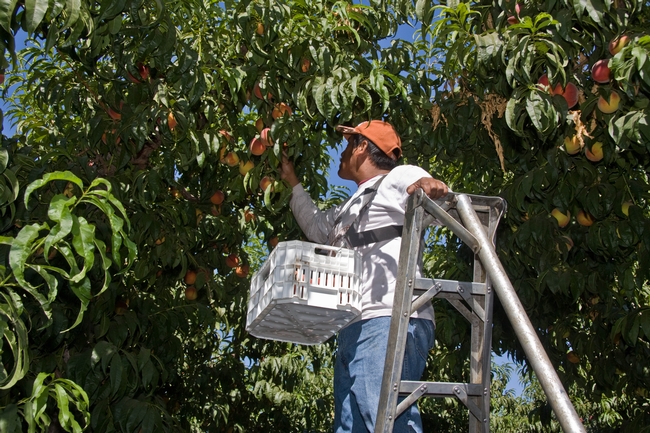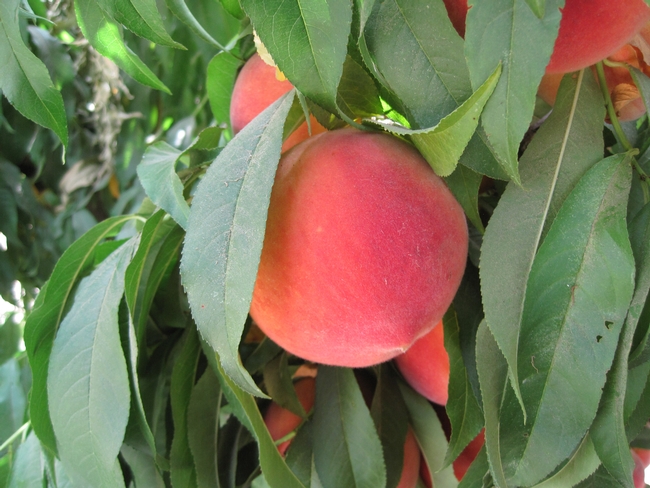Late-harvest processing peaches produce more profit, new UC studies show
Tree fruit growers can receive premiums for delivering certain extra-early varieties of peaches, but peach farmers may net roughly $800 more per acre from late-harvest processing peaches than extra-early harvest varieties, according to new cost studies released by the UC ANR Agricultural Issues Center and UC Cooperative Extension.
To help farmers make decisions on which peach varieties to plant, UC researchers present sample costs to produce extra-early harvested cling and freestone peaches and late harvested cling and freestone peaches for processing in the Sacramento and San Joaquin Valley in these studies.
Although processors pay more for extra-early harvested peach varieties than late-harvest peaches, the researchers found that yields are higher for late-harvest varieties while costs for hand thinning the fruit are lower.
“Peaches harvested early in the season have less time to grow compared to peaches that get to hang on the tree another month or more,” explained Roger Duncan, UC Cooperative Extension advisor in Stanislaus County, who coauthored the studies. “Therefore, more fruit has to be removed so the remaining fruit can size. That means it costs you more to produce less.”
The analyses are based upon hypothetical well-managed farming operations using practices common to the region. The costs, materials and practices shown in these studies will not apply to all farms. Growers, UC ANR Cooperative Extension farm advisors and other agricultural associates provided input and reviewed the methods and findings of the study.
Both studies assume a 100-acre farmer-owned operation with 40 acres of cling peaches. The remaining acreage for both hypothetical farms is planted in other mature tree crops. The estimated economic life of the extra-early harvested cling peach orchard and the late harvested cling peach orchard is 18 years.
Some of the major differences between the two studies are return price, yield and fruit thinning cost. The extra-early harvested varieties have a price of $545 per ton, a yield of 17 tons per acre, and a thinning cost of $1,445 per acre. The late harvested varieties have a price of $490 per ton, a yield of 20 tons per acre, and a thinning cost of $1,177 per acre.
Asked if a small farm could save on fruit thinning expenses by doing it themselves, Duncan replied, “I guess it would be possible for a small family operation to do the thinning themselves, but not likely. It can take 20 to 40 minutes to thin a single tree. If there are 151 trees per acre, you can see that it would take one skilled person over a week to thin one acre.”
The authors describe the assumptions used to identify current costs for production material inputs, cash and non-cash overhead. Ranging analysis tables show net profits over a range of prices and yields. Other tables show the monthly cash costs, the costs and returns per acre, hourly equipment costs, the whole farm annual equipment, investment and business overhead costs and the operations with equipment and materials.
Free copies of “Sample Costs to Produce Processing Peaches, Cling and Freestone Extra-early Harvested Varieties, in the Sacramento and San Joaquin Valley – 2017” and “Sample Costs to Establish and Produce Processing Peaches, Cling and Freestone Late Harvested Varieties, in the Sacramento and San Joaquin Valley – 2017” are available on the UC Davis Department of Agricultural and Resource Economics website at https://coststudies.ucdavis.edu. Sample cost-of-production studies for many other commodities are also available.
The cost study program is funded by the UC Agricultural Issues Center and UC Cooperative Extension, both part of the UC Division of Agriculture and Natural Resources, and the UC Davis Department of Agricultural and Resource Economics.
For additional information or an explanation of the calculations used in the studies, contact Jeremy Murdock at the Agricultural Issues Center, at (530) 752-4651, Janine Hasey, UC Cooperative Extension advisor for Sutter/Yuba counties, at (530) 822-7515, or Duncan at (209) 525-6800.


